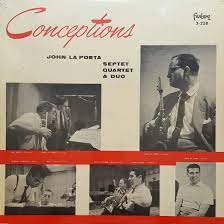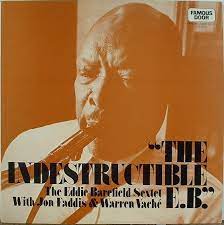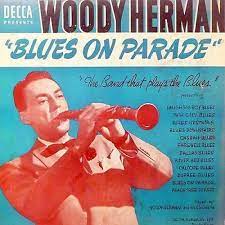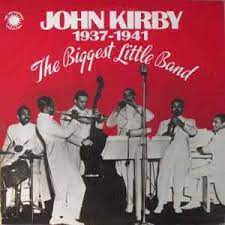
Daily Dose Of Jazz…
Louis Raphael Mucci was born December 13, 1909 in Syracuse, New York and began as a baritone horn player and was appearing in professional settings by the time he was ten years old. As a teenager he switched to trumpet and worked in the late 1930s with Mildred Bailey and Red Norvo before joining Glenn Miller’s ensemble in 1938-1939.
During World War II he played in the bands of Bob Chester, Hal McIntyre, Claude Thornhill, and Benny Goodman. In the first half of the 1950s Lou worked as a house musician for CBS and also recorded with Buddy DeFranco and Artie Shaw. Later in the decade he worked with Helen Merrill, John LaPorta and Miles Davis, the latter lasting into the early Sixties.
Trumpeter Lou Mucci, who also played with Kenny Burrell in 1964, transitioned on January 4, 2000.
More Posts: history,instrumental,jazz,music,trumpet

Daily Dose Of Jazz…
Edward Emanuel Barefield was born on December 12, 1909 in Scandia, Iowa, and grew up in Des Moines, Iowa. His father was a guitarist, his mother a pianist. He began playing the saxophone at the age of twelve when his mother bought him the instrument as a Christmas gift, and he took it apart to see how it worked.
He started playing throughout the Midwest, and gained his first major big-band experience with the Bennie Moten Orchestra of 1932. This led to work with Zach Whyte’s band and at 24 was offered a position in Cab Calloway’s orchestra in 1933. Eddie arranged and wrote music for Calloway for over 40 years.
Barefield conducted the orchestra for Ella Fitzgerald after Chick Webb passed away in 1939. In addition, he performed with McKinney’s Cotton Pickers, Les Hite, Fletcher Henderson, Don Redman, and Benny Carter. After the end of the big band era he continued to work by conducting shows, free-lancing, and playing in Europe.
He was the musical director for the original Broadway production of Streetcar Named Desire in 1947. He spent a decade in the band of the Ringling Brothers and Barnum & Bailey Circus, and composed and arranged for Benny Goodman, Glenn Miller, Paul Whiteman, and Jimmy Dorsey. Later in his life, Barefield worked with the Illinois Jacquet big band. Eddie appeared in films, including Cab Calloway’s Hi-De-Ho, Al Jolson’s The Singing Kid, Every Day’s a Holiday, and The Night They Raided Minsky’s.
Saxophonist, clarinetist and arranger Eddie Barefield, who arranged for the ABC Orchestra, transitioned from a heart attack at Mount Sinai Hospital in New York on January 4, 1991.
More Posts: arranger,bandleader,clarinet,history,instrumental,jazz,music,saxophone

Daily Dose Of Jazz…
Matty Malneck born Matthew Michael Malneck on December 9, 1903 in Newark, New Jersey and his career as a violinist began when he was age 16. He was a member of the Paul Whiteman orchestra from 1926 to 1937. During the same period he recorded with Mildred Bailey, Annette Hanshaw, Frank Signorelli, and Frankie Trumbauer.
He led a big band that recorded for Brunswick, Columbia, and Decca. His orchestra provided music for The Charlotte Greenwood Show on radio in the mid-1940s and Campana Serenade in 1942–1943. His group played in the film St. Louis Blues in 1939 and You’re in the Army Now in 1941. At this point in his career he changed the group’s name to Matty Malneck and His St. Louis Blues Orchestra.
Malneck’s credits as a songwriter and composed hit songs such as Eeny Meeny Miney Mo and Goody Goody, both with lyrics by Johnny Mercer, I’ll Never Be The Same, with music by Malneck & Frank Signorelli, lyrics by Gus Kahn, and I’m Thru With Love, music by Malneck & Fud Livingston, lyrics by Kahn.
Violinist, songwriter, and arranger Matty Malneck transitioned on February 25, 1981.
More Posts: arranger,bandleader,composer,history,instrumental,jazz,music,violin

Daily Dose Of Jazz…
Joe Bishop was born November 27, 1907 in Monticello, Arkansas and learned piano, trumpet, and tuba when he was young. He also played flugelhorn and mellophone. He attended Hendrix College and played professionally with the Louisiana Ramblers in 1927, including in Mexico.
Bishop played with Mart Britt, Al Katz, and Austin Wylie before joining the Isham Jones band for five years. He was a founding member of Woody Herman’s band in the 1930s, but he contracted tuberculosis in 1940 and had to leave the group. He was rehired by Herman as a staff arranger later in the 1940s, and his arrangements and compositions were recorded frequently by Herman, appearing on some 50 of Herman’s albums.
As a performer, Joe played with Cow Cow Davenport and Jimmy Gordon’s Vip Vop Band, but retired from studio work due to his health in the 1950s. Joe quit music and opened a store in Saranac Lake, New York, and later retired to Texas. His compositions include Midnight Blue, Woodchopper’s Ball, and Blue Prelude with Gordon Jenkins.
Tubist, pianist and composer Joe Bishop, whose work has been covered by musicians as diverse as Ten Years After and Lawrence Welk, transitioned on May 12, 1976.
More Posts: composer,history,instrumental,jazz,music,piano,tuba

Daily Dose Of Jazz…
William “O’Neil” Spencer was born on November 25, 1909 in Cedarville, Ohio and began his career with local bands in the Buffalo, New York area. In 1931, he began working for Al Sears before joining up with the Mills Blue Rhythm Band from 1931 to 1936, which later became the Lucky Millinder Orchestra.
However, it wasn’t until 1937 after joining the popular John Kirby Sextet that he truly became an influential force on the jazz scene. Unfortunately, Spencer had to leave for a time in 1941 due to tuberculosis. However, during the late Thirties he recorded with numerous other groups, including Red Allen, Sidney Bechet, Jimmie Noone, Johnny Dodds, Frankie Newton, Milt Hearth, and Lil Armstrong.
He left the Kirby sextet in 1941 to work briefly with Louis Armstrong, but returned in ’42. His career, however, was cut short in 1943 when he contracted tuberculosis. Drummer and singer O’Neil Spencer transitioned on July 24, 1944 in New York City at the age of thirty-five.
More Posts: drums,history,instrumental,jazz,music



